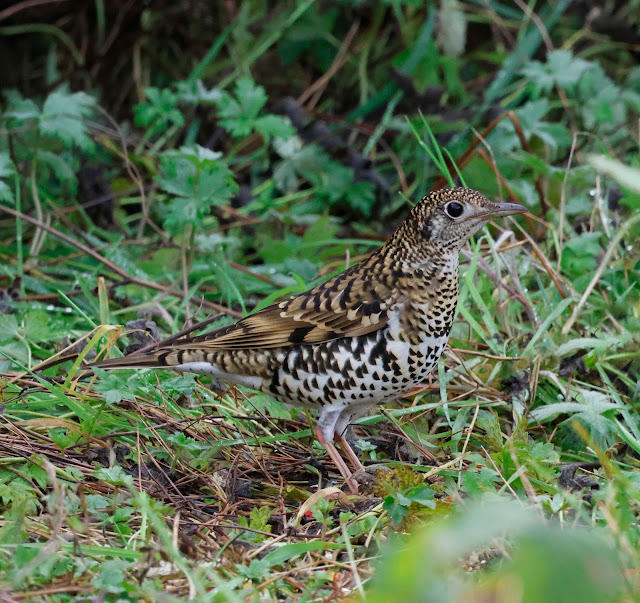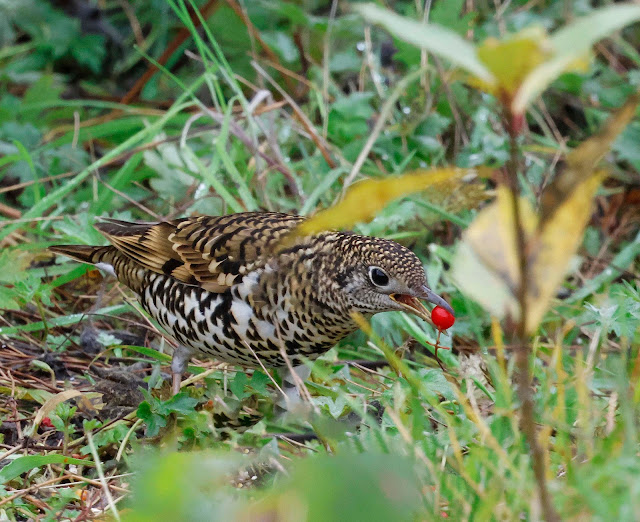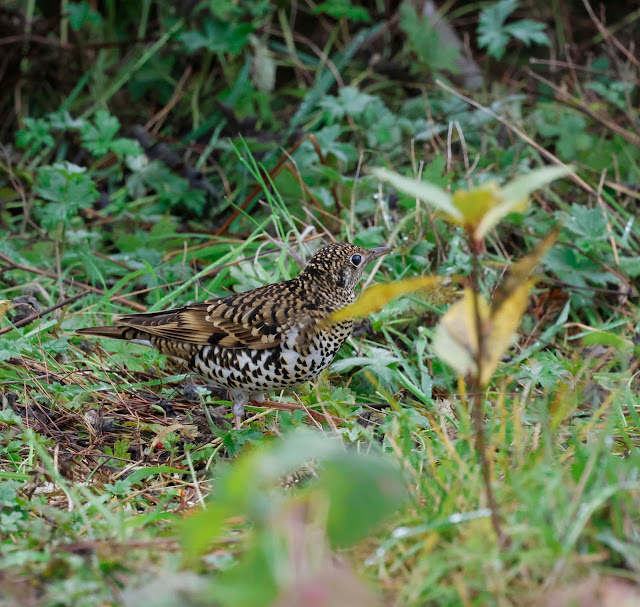Shortly after breakfast on Thursday the 5th of October any doubt about where to go birding was dispelled by the Shetland Rare Bird News WhatsApp Group announcing the discovery of a White's Thrush. late on the 4th of October in a small plantation at a place called Gorie on Bressay, the small island that lies to the east and just opposite Lerwick on Mainland.
White's Thrush is without exaggeration my ultimate bird. Every birder has their favourite and for me this bird is the tops.Maybe it's the intricately patterned plumage, the bird's elusiveness or just plain charisma.Whatever it is I cannot get enough.
With one or two matters to attend to in Lerwick we only arrived at the ferry mid morning to make the ten minute crossing to Bressay. The point of departure and arrival could not be more different. The Lerwick departure point, busy and situated in a built up area of an industrial part of the town while the arrival point on Bressay is just a tiny pier with no more than a few houses and a single small road leading off into the moors of Bressay.
As we anticipated, the small ferry was mainly full of birder's cars and we knew that our comparatively late departure meant that many birders had preceded us on earlier ferries which run every hour and we would be lucky to find a parking place near Gorie which is, without exaggeration, in the middle of nowhere. There is some limited parking on the road by a loch but sure enough when we arrived all places were occupied and an overflow of cars stretched into the distance along one verge of the single track road. In the end we were obliged to park in a large passing place further up the road and walk back a quarter of a mile to where a track led off to our left between the loch and the moorland.
It was a long and wearisome walk down the metalled road and then up a rising, rutted, puddle strewn track that took us for half a mile towards Gorie and the plantation which was, as they usually are a fenced off rectangle of mixed deciduous and conifer woodland created both as habitat for wildlife and as a windbreak.There was a small house and wooded garden a couple of hundred metres adjacent. These two areas were the only available habitat of its kind for miles.
Apparently the White's Thrush commuted between the two but preferred the more extensive and denser cover of the larger plantation.
White's Thrush approaches mythical status amongst birders such as myself. A bird almost without exception that is found on northern islands and only very occasionally on the mainland of Britain. They rarely remain for long, sometimes just a day and are incredibly hard to see with many birders contenting themselves with flight views only as it flees from one area of cover to another.
In recent years records of this most desired thrush have been increasing and now two or three are usually found each autumn in Britain and its status is not what it was thirty years ago. However it still engenders a thrill like no other when one is found here and remains a very rare bird with only 94 currently accepted records.
Charismatic, its secretive behaviour only adds to the myth and it seems to embody the very spirit of the vast and mysterious Siberian forests it comes from.It is large, about the size of a Mistle Thrush and elusive, being excessively shy but when seen, even for a few seconds, is an extraordinarily beautiful bird with its golden buff and white body overlaid with a complex scaly patterning of prolific black spots, lines and chevrons.
When we got to the site birders were standing around the outside of the plantation and the house garden awaiting the thrush to make one of its periodic flights between the two locations.General access to the plantation was strictly forbidden but we could go in and sit just inside one small area at the edge of the wood, joining several others sitting silently on the woodland floor.This was as far as you were permitted to go.
I sat on the ground amongst half a dozen others and a whispered conversation with a neighbouring birder revealed that by looking down an indeterminate trail that sloped away in front of us into the densest part of the plantation and by laying on one's side, almost prostrate, it was sometimes possible to see the thrush on the ground but always at a great distance. Frankly I struggled as any birds were just shapes and anyway were mainly Blackbirds and Blackcaps as far as I could see, obscured by much intervening vegetation and tree trunks between me and where the thrush was meant to occasionally show itself. I honestly could not say whether I had seen it or not although others in a better position on the woodland floor swore they had.
To find oneself lying here in the mud and damp leaves for a hoped for seconds only view of a White's Thrush was surely testing the realms of sanity but such is twitching and the stuff of which legends are made and to be spoken of later in the pub or curry house.
Without warning the bird flew out of the wood towards the house and everyone sat around myself and Andy left to try and see it in the garden.We remained where we were content to wait and now with everyone gone got the best positions to see down into the wood.We knew that the thrush would be back but did not expect it to be as soon as ten minutes later when it landed not 30 metres away to our right but invisible in the dense woodland. Fifteen minutes later it flew again, passing in front of us, right to left, fast and low, a fleeting image of pale brown and white and then was gone into an impenetrable tangle of bushes and trees to our left.
Birders returned to join us and soon it was back to cramped viewing conditions once more.The thrush occasionally showed itself and by once more lying on my side and looking down the trail I saw it briefly, hopping on the ground and then it was gone again.
I motioned to a similarly prostrate Andy and we decided to call it quits and left the wood.I had seen my second White's Thrush ever in Britain but I felt distinctly underwhelmed by the experience.
On Monday the 9th of October Mark and myself went for a walk alongside Loch Clickimin on the outskirts of Lerwick, the loch where we saw a White's Thrush so very well on exactly the same day last year. Sadly there was no White's Thrush here today but only a Siberian Chiffchaff with a Goldcrest for company.We met another birder, Andrew who turned out to be the finder of the White's Thrush last year.Strange how these coincidences happen.
In the intervening days after our visit to Bressay superb images of the White's Thrush had appeared on social media and it was obvious it was granting better views, the reason being it now could be seen by standing outside the wood at the bottom left corner of the plantation.
I began to consider another trip to Bressay. Today the weather was pleasant, sunny and absolutely calm with not a breath of wind, the loch mirror flat
We decided there and then on another visit to Gorie, reasoning the benign weather would grant us the best opportunity to see the thrush well and also we knew that most people having already seen the thrush, it would be much less crowded and we might even have it to ourselves as others already had.
We took the ferry mid morning and as anticipated, this time parking was not a problem, although the presence of a few cars suggested we would have company. Another yomp over the moorland got us to the plantation.
We met a departing Ray who told us that with patience the thrush would show really well in the favoured far corner of the plantation.
We made for the bottom corner following an indeterminate and slippery track that ran along the outside of an ancient, crumbling dry stone wall, guarding the wood.
To our relief there were just three birders there as opposed to around sixty when we came earlier and I had no doubt that the absence of a large number of birders would prove a distinct advantage when it came to viewing the thrush.
The place where we stood overlooked a small open area, a corner of rank grass, rosa bushes and shrubs with beyond, the edge of the woodland proper
Now all we could do was hope.We stood silently waiting for developments.
Blackcaps and Bramblings kept us entertained as they flew back and fore over the rough grass and to and from the fringes of the wood.Up to a dozen male and female Blackcaps flew around and down into the grass hunting for berries and invertebrates.Occasionally a migratory Redwing or Blackbird would join them.
It had materialised from seemingly nowhere and my new camera and lens combo picked out its spangled body, all spots and crescents and its huge black eyes adapted for just such a dull environment. Bulky, it moved with heavy hops and performed a curious circular dance as it fed, then it was gone just as mysteriously as it had appeared, fading first to a black silhouette and then just a shadow that merged imperceptibly into nothing.
With such views it was certainly living up to its enigmatic reputation but then ten minutes later came the moment we had been anticipating. A fair way from where it had last been seen it apppeared just outside the woodland edge, fully in the open. A glorious open air vision of cryptic buff, white and black scaling.I raised my camera to capture the moment but I was a fraction too slow and it had retreated back into the security of the wood.
A few tantalising glimpses of it emerging from cover came and went but it never remained long enough for me to get a photo.Forever wary and obviously uneasy about its relative exposure in the grass it was palpably anxious but the berries were a temptation that was hard to resist.
Blackcaps continued to fly hither and thither and more Bramblings dropped from the sky to feed at the edge of the woodland, even a Siberian Chiffchaff came and went, its plumage strikingly pale amongst the green leaves of a willow.
Half an hour passed with no further sign of the thrush.
It consistently managed to elude us, for having seen it in one spot we never saw it move away but it must have done while in the cover of the wood as it would next appear in a totally different place. However it favoured a particular edge of the wood where a willow drooped down like a curtain to the grass and it was from here it would mostly emerge.
And so it was that it finally made another entrance from this area of the wood and hopped out onto the grass. I held my breath, tension running like an electric current through my body.
The thrush stood still, as tense as me, alert, assessing the situation, ready to flee in an instant at the slightest intimation of danger.I prayed that this would be the moment it remained.
Seconds seemed like minutes as it stood immobile, head raised but at last it relaxed, well as far as a bird as highly strung as a White's Thrush can ever achieve and hopped out further to lower its head and pick up a bright red berry in its bill, swallow it and then, stood for a moment before turning and retreating back into cover. It had been in the open for too long and needed the re-assurance of the dark shaded woodland's interior.
This camera shy bird was in the open for no more than four minutes but what minutes they were, as in that time available I could absorb every detail of its sublime plumage and savour this rarest of moments in its presence.
It was over and I walked on air up the muddy track by the haphazard drystone wall to the upper end of the plantation. A ride divided the main wooded area from another rectangle of birch woodland protected by a chicken wire fence.
A momentary flick of pale buff caught my eye. Gone as soon as it registered. Surely not a Blackcap but what was it?
My puzzlement was answered as the bird appeared again and obligingly perched on the fence.It was a juvenile Red breasted Flycatcher. Now if Carlsberg did lovable endearing flycatchers this would surely be it.
I watched it for twenty minutes before it disappeared into the main part of the wood.Turning to go I saw a group of seven very small birds flying towards me, descending off the moorland to settle in the pines where they flitted about hunting insects.They were Goldcrests. Had they just made landfall as migrants falling from the sky at the sight of the first suitable habitat?.
I would like to think so.
It had been that sort of a day.


.jpg)
.jpg)
.jpg)
.jpg)

























.jpg)




No comments:
Post a Comment